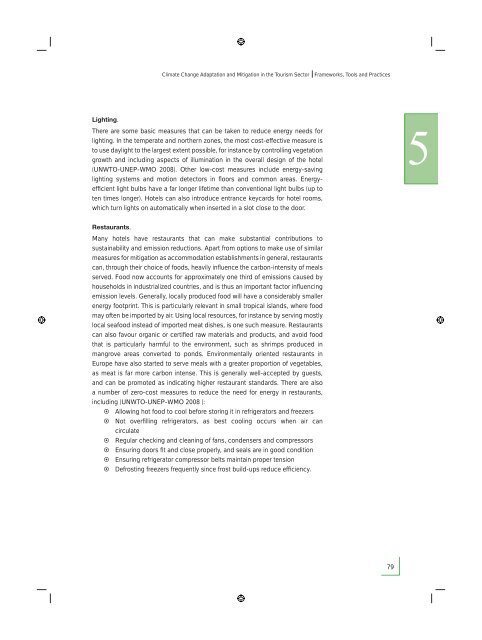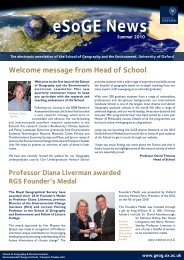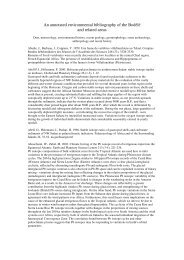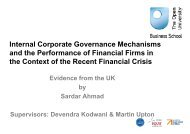Climate Change Adaptation and Mitigation in the Tourism Sector
Climate Change Adaptation and Mitigation in the Tourism Sector
Climate Change Adaptation and Mitigation in the Tourism Sector
Create successful ePaper yourself
Turn your PDF publications into a flip-book with our unique Google optimized e-Paper software.
<strong>Climate</strong> <strong>Change</strong> <strong>Adaptation</strong> <strong>and</strong> <strong>Mitigation</strong> <strong>in</strong> <strong>the</strong> <strong>Tourism</strong> <strong>Sector</strong> Frameworks, Tools <strong>and</strong> Practices<br />
Light<strong>in</strong>g.<br />
There are some basic measures that can be taken to reduce energy needs for<br />
light<strong>in</strong>g. In <strong>the</strong> temperate <strong>and</strong> nor<strong>the</strong>rn zones, <strong>the</strong> most cost-effective measure is<br />
to use daylight to <strong>the</strong> largest extent possible, for <strong>in</strong>stance by controll<strong>in</strong>g vegetation<br />
growth <strong>and</strong> <strong>in</strong>clud<strong>in</strong>g aspects of illum<strong>in</strong>ation <strong>in</strong> <strong>the</strong> overall design of <strong>the</strong> hotel<br />
(UNWTO-UNEP-WMO 2008). O<strong>the</strong>r low-cost measures <strong>in</strong>clude energy-sav<strong>in</strong>g<br />
light<strong>in</strong>g systems <strong>and</strong> motion detectors <strong>in</strong> fl oors <strong>and</strong> common areas. Energyeffi<br />
cient light bulbs have a far longer lifetime than conventional light bulbs (up to<br />
ten times longer). Hotels can also <strong>in</strong>troduce entrance keycards for hotel rooms,<br />
which turn lights on automatically when <strong>in</strong>serted <strong>in</strong> a slot close to <strong>the</strong> door.<br />
Restaurants.<br />
Many hotels have restaurants that can make substantial contributions to<br />
susta<strong>in</strong>ability <strong>and</strong> emission reductions. Apart from options to make use of similar<br />
measures for mitigation as accommodation establishments <strong>in</strong> general, restaurants<br />
can, through <strong>the</strong>ir choice of foods, heavily <strong>in</strong>fl uence <strong>the</strong> carbon-<strong>in</strong>tensity of meals<br />
served. Food now accounts for approximately one third of emissions caused by<br />
households <strong>in</strong> <strong>in</strong>dustrialized countries, <strong>and</strong> is thus an important factor <strong>in</strong>fl uenc<strong>in</strong>g<br />
emission levels. Generally, locally produced food will have a considerably smaller<br />
energy footpr<strong>in</strong>t. This is particularly relevant <strong>in</strong> small tropical isl<strong>and</strong>s, where food<br />
may often be imported by air. Us<strong>in</strong>g local resources, for <strong>in</strong>stance by serv<strong>in</strong>g mostly<br />
local seafood <strong>in</strong>stead of imported meat dishes, is one such measure. Restaurants<br />
can also favour organic or certifi ed raw materials <strong>and</strong> products, <strong>and</strong> avoid food<br />
that is particularly harmful to <strong>the</strong> environment, such as shrimps produced <strong>in</strong><br />
mangrove areas converted to ponds. Environmentally oriented restaurants <strong>in</strong><br />
Europe have also started to serve meals with a greater proportion of vegetables,<br />
as meat is far more carbon <strong>in</strong>tense. This is generally well-accepted by guests,<br />
<strong>and</strong> can be promoted as <strong>in</strong>dicat<strong>in</strong>g higher restaurant st<strong>and</strong>ards. There are also<br />
a number of zero-cost measures to reduce <strong>the</strong> need for energy <strong>in</strong> restaurants,<br />
<strong>in</strong>clud<strong>in</strong>g (UNWTO-UNEP-WMO 2008 ):<br />
§ Allow<strong>in</strong>g hot food to cool before stor<strong>in</strong>g it <strong>in</strong> refrigerators <strong>and</strong> freezers<br />
§ Not overfi ll<strong>in</strong>g refrigerators, as best cool<strong>in</strong>g occurs when air can<br />
circulate<br />
§ Regular check<strong>in</strong>g <strong>and</strong> clean<strong>in</strong>g of fans, condensers <strong>and</strong> compressors<br />
§ Ensur<strong>in</strong>g doors fi t <strong>and</strong> close properly, <strong>and</strong> seals are <strong>in</strong> good condition<br />
§ Ensur<strong>in</strong>g refrigerator compressor belts ma<strong>in</strong>ta<strong>in</strong> proper tension<br />
§ Defrost<strong>in</strong>g freezers frequently s<strong>in</strong>ce frost build-ups reduce effi ciency.<br />
79<br />
5








